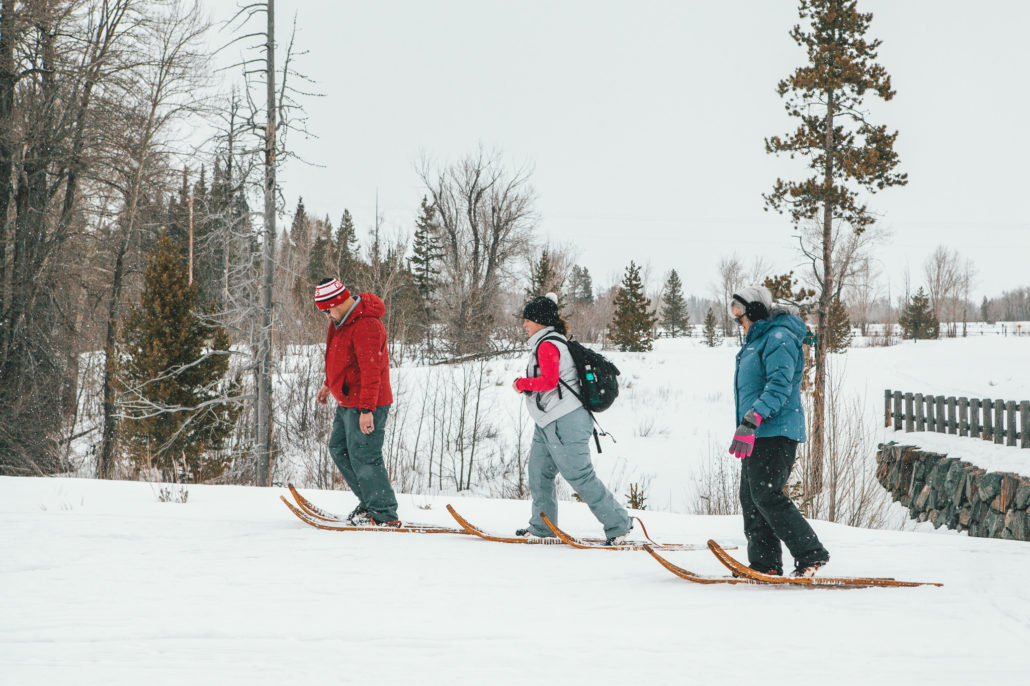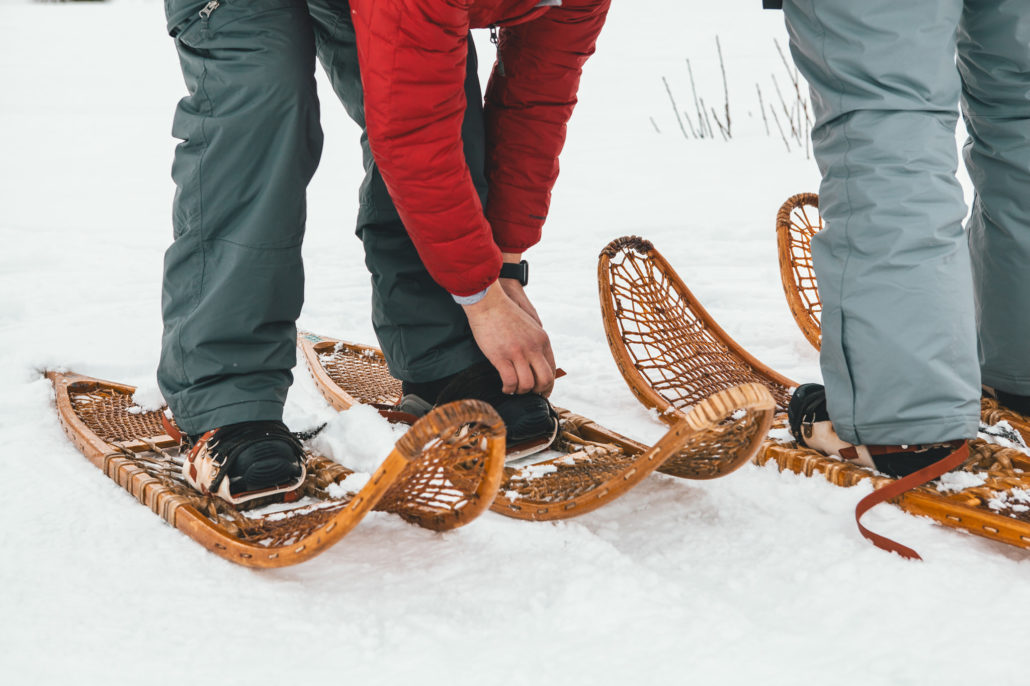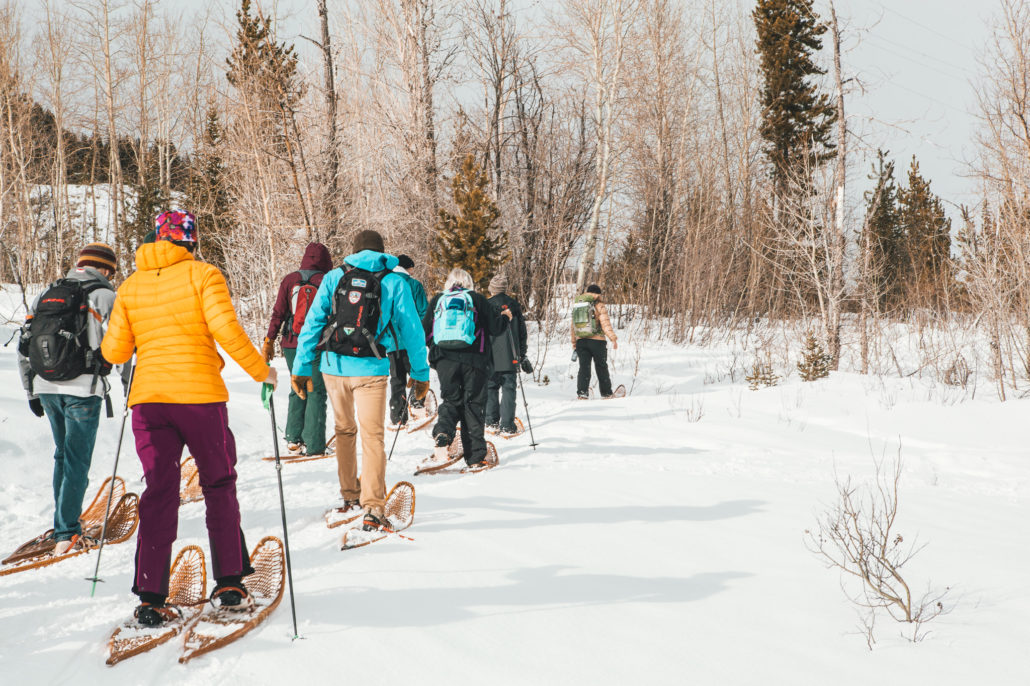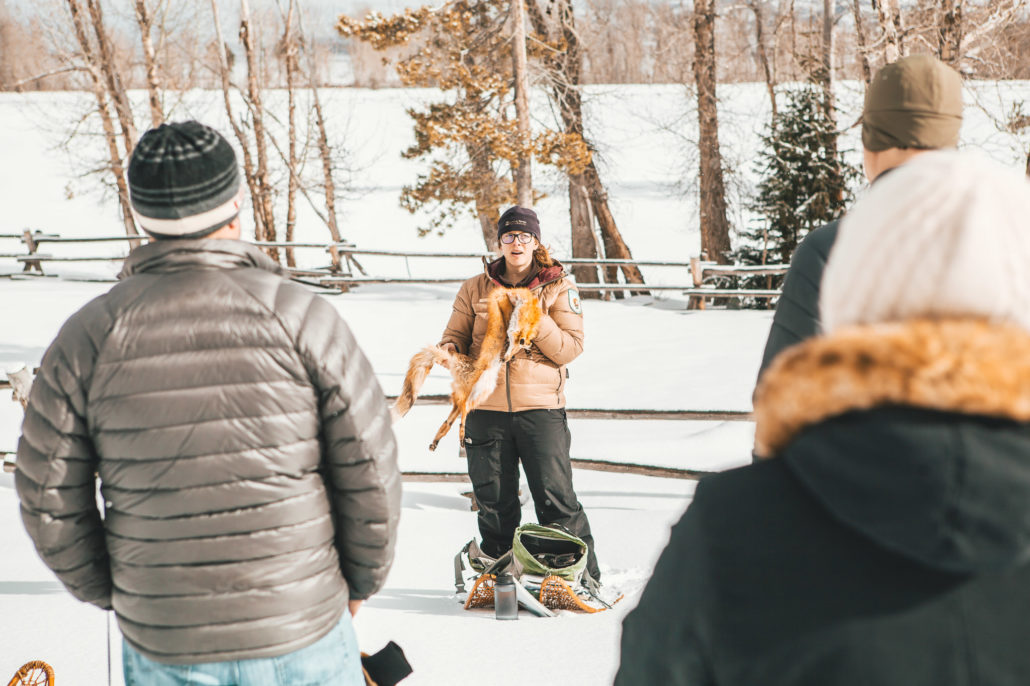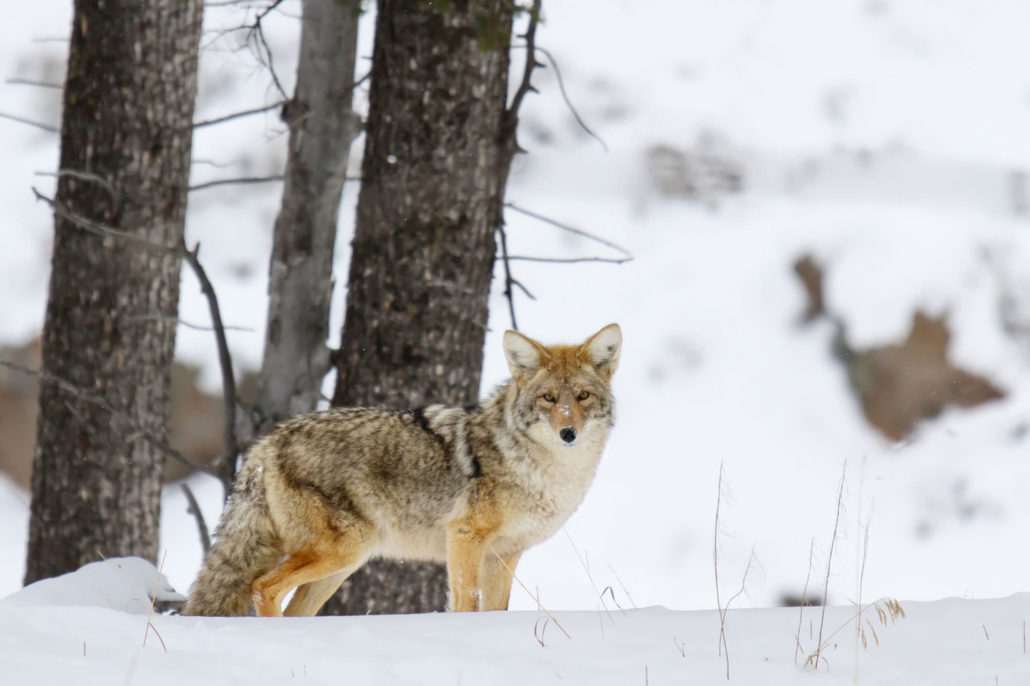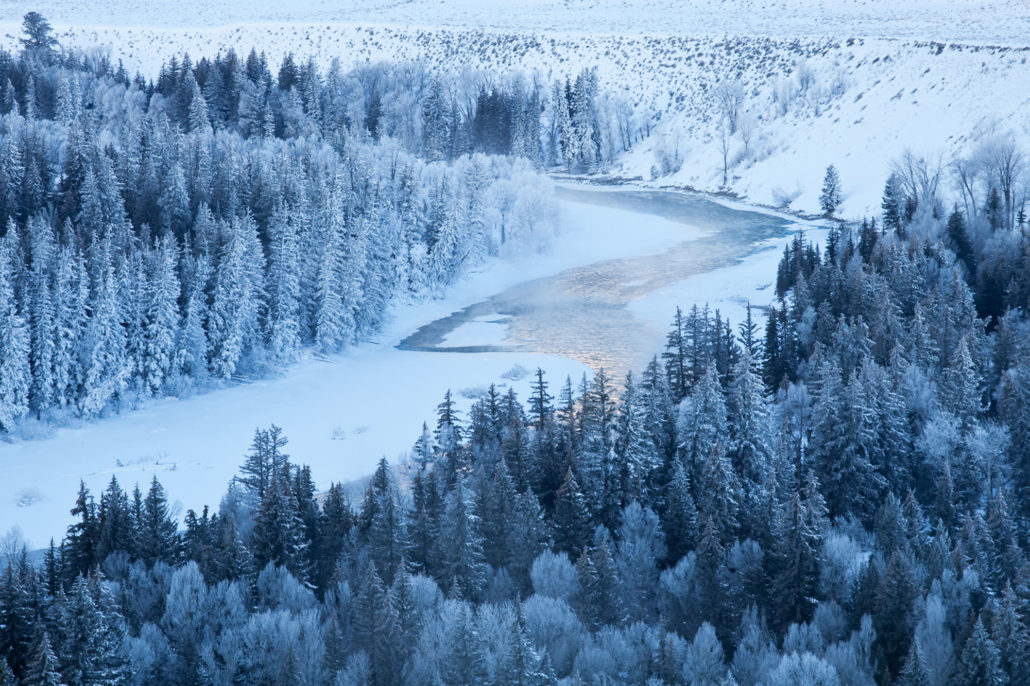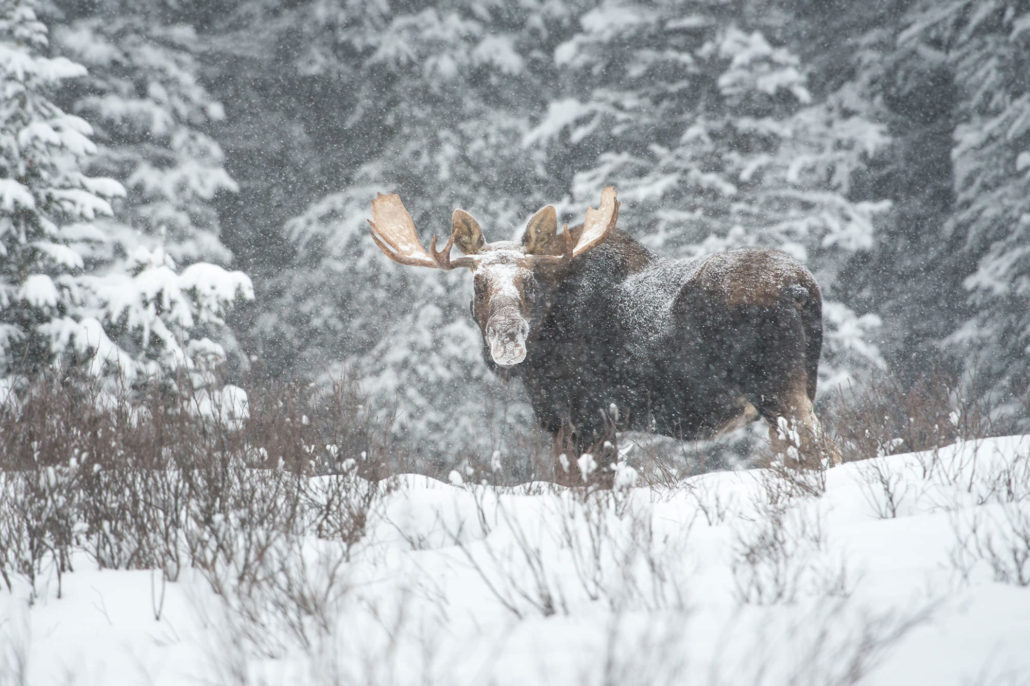A snowshoe hike in Grand Teton National Park can transform how you think about winter, and it will leave you with some pretty amazing photos, and memories, too.
“Go ahead; grab a handful of snow and eat it,” says Katie Tozier, the Grand Teton National Park Naturalist leading one of the park’s three, weekly snowshoe hikes. “Close your eyes. Take a deep breath. Be quiet. What does winter feel like today in Grand Teton National Park?” Tozier doesn’t make our group of about 20 answer her question, immediately and encourages us to marinate on it as we head toward the glacial moraine, east of the park’s Bradley Taggart Trailhead.
There is nothing quite like walking through a snowy forest.
Snowshoeing in Grand Teton National Park is gorgeous and a bucket list item for many winter visitors. We’ve snowshoed in the park dozens of times—on cloudless, bluebird days and when it’s been snowing sideways. We’ve snowshoed and seen moose; other times we’ve seen only squirrels. We’ve had the parking lots of various trailheads all to ourselves, and other days it’s been so busy we had to park our car on the shoulder of the road. We thought we’d had every snowshoe experience GTNP had to offer. And then early this February, we participated in one of the park’s free, naturalist-guided snowshoe hikes.
Snowshoeing in GTNP is always an experience to remember, and joining one of the organized snowshoe tours with a ranger naturalist, makes it even more so.
One member of our group leans down and picks up a handful of snow in his gloved hand. He studies it closely for several seconds, “You can see individual snowflakes,” he notes, then gently blows at it, which sends about one-third of the flakes out of his hand and into the air. Then he brings his hand up to his mouth, and heeding Tozier’s advice, eats what he didn’t blow away. “It’s crunchy.”
The rest of us study tracks on the ground, trying to discern whether or not the deep ones are from a snowshoe-less human postholing, or from a moose. We walk up to a lodgepole pine, close our eyes, stick our face into it, and inhale deeply. With our head and face inside its branches, we don’t just smell the pine tree, but also hear its needles, most of which are caked with snow and ice, brushing each other. In all our days snowshoeing in the park prior to this trip with Tozier, we’ve never paid attention to details like this.
The noise from the needles sounds similar to a lint roller as it debugs a favorite cashmere sweater. But, standing in a grove of pine trees at the base of the youngest mountain range in the Rockies, there is none of life’s usual background noises to distract us—traffic on the street, a running dishwasher or dryer, music, chatter. Tozier says what we’re thinking: “There is nothing quite like walking through a snowy forest.”
Stopping near the corner of a field where, during the summer, the park trail crew’s horses live, we huddle around Tozier, who has taken off her overstuffed backpack, and from it pulled out a stack of laminated sheets, as well as a Nalgene bottle filled with water. She asks whether anyone needs some of the latter, then whether we have a guess as to the coldest-ever temperature recorded in the park.
One winter day in 1933, a temperature of -63 degrees Fahrenheit was recoded in Moran, in the northern park of the park. Tozier goes on to explain that while that was certainly an outlier, the valley usually gets about 14 days every winter, with temperatures between -20 and -30 degrees Fahrenheit. If learning was always this much fun!
Details
The ranger-led snowshoe tours in Grand Teton National Park begin at 1:30 p.m. every Tuesday, Thursday, and Saturday between mid-December and early-March (the end of the season is weather dependent). Tours start at the Bradley-Taggart Lakes trailhead, cover about one mile, and last for about two hours. Included in the tour is the use of historic ash-and-rawhide snowshoes dating from the 1940’s and 1950’s. Reservations are required and can be made by calling (307) 739-3399. At the time you make a reservation, a ranger will talk to you about what to you’ll need to bring. These tours are free, but a $5 donation, which goes to the upkeep of the snowshoes, is suggested.
Her next question is about how much snow falls in the mountains just in front of us, but mostly hidden by clouds. “In inches,” she specifies. The first guess is 125. “That’s about how much snow falls in the valley,” Tozier says. “What about several thousand feet higher?” Incredulously, someone offers up 376 inches, the tone of her voice suggesting she thinks she’s way overestimated it. But no, 376 is still too low. The Tetons get, on average, between 400 and 450 inches of snow every winter, enough to bury a three-story building.
Even the locals on this adventure shake their heads at the idea of this much snow, as we snowshoe deeper into the glacial moraine.
At our next two stops, we learn about the animals that live in the park and some of their adaptations that allowed them to survive. The back legs of moose have “knee” joints that bend in the opposite direction of ours. This allows them to punch down into snow, then more easily pull their legs up and out. Uinta ground squirrel’s hibernation lasts up to nine months. Standing on top of the snow, red fox can hear rodents moving around in the subnivean zone—the area between the surface of the ground and the bottom of the snowpack that can be up to five feet below a fox’s feet. A wolverine can smell a frozen carcass beneath seven feet of snow, and it can chew through bone.
For those who want to see a red fox and wolverine up close, Tozier has pelts of each for us to pass around. It is while examining the wolverine, which is one of the least-often seen animals in the area—we’ve hiked hundreds and hundreds of miles all around the valley and haven’t seen more than a wolverine footprint—we decide this snowshoeing adventure is now at the top of our list to do with visiting family and friends.
Snowshoeing in Grand Teton National Park is perhaps one of the Jackson Hole winter season’s most inspiring activities. For those looking to experience this unforgettable adventure first hand, The Clear Creek Group’s Concierge Team is available to assist with the arrangements.

